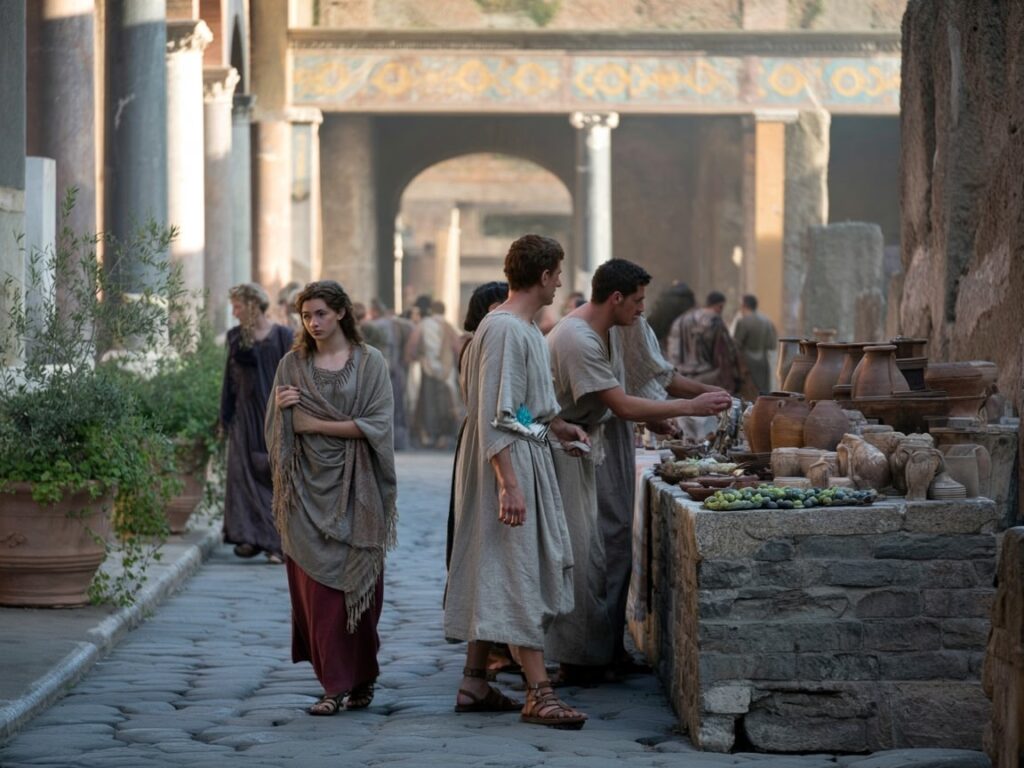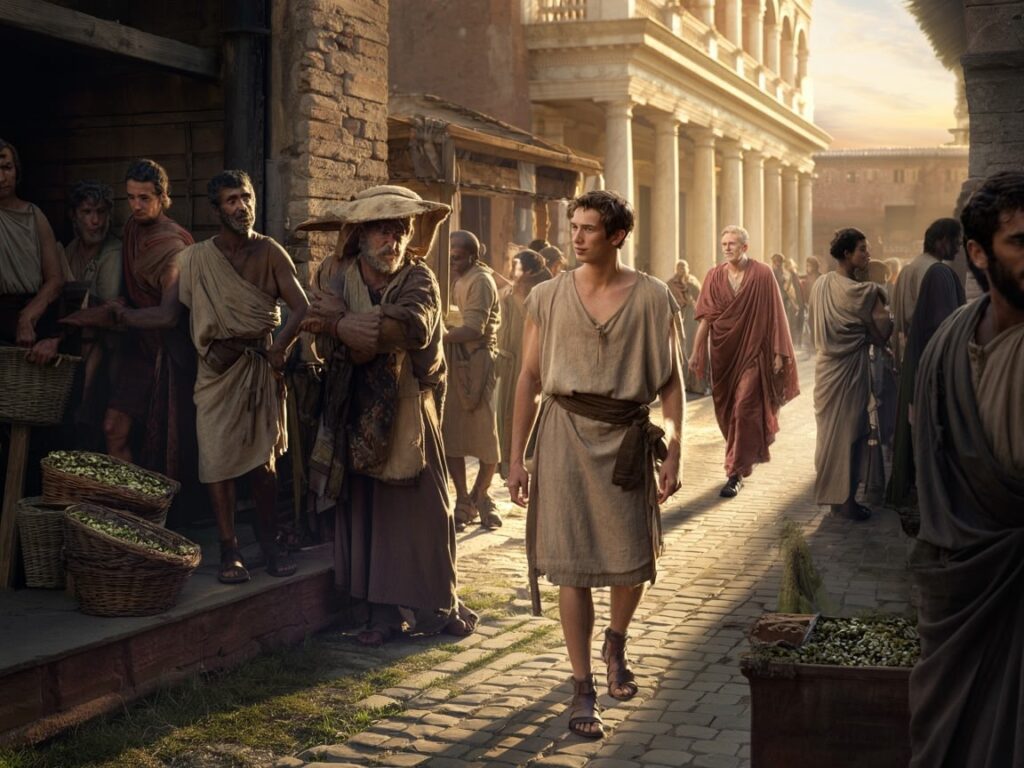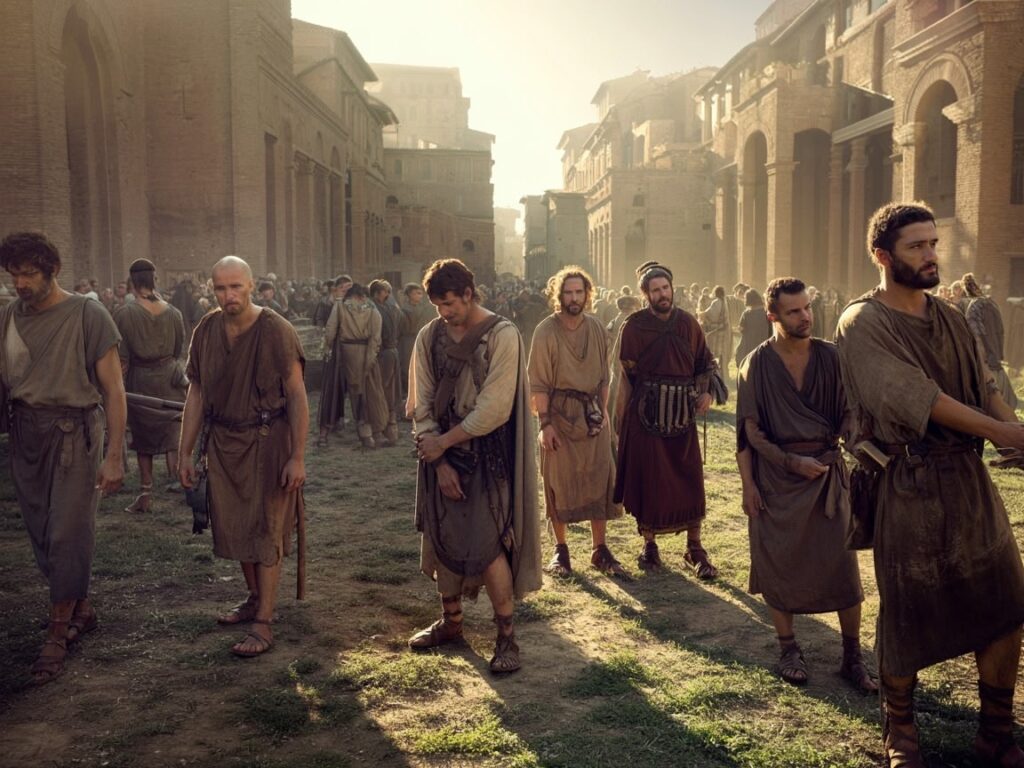The Structure of Roman Society and the Underclass
Roman society had a strict social hierarchy with clear divisions between groups based on birth, legal status, and freedom. At the top were freeborn citizens, who were further divided into:
- Senators: The political elite making important decisions for the state
- Equestrians: Wealthy businessmen and landowners who ranked below senators
- Non-privileged citizens: Ordinary Roman citizens without any special rights
Below freeborn citizens were non-citizens, including peregrini (foreigners) and provincials, who didn’t have full legal rights but could sometimes become citizens.
A large part of the population consisted of slaves, who had no legal rights and were treated as property. Slavery was widespread in every aspect of life, from rural farms to busy city homes. Rural slaves worked in the fields, took care of animals, or did manual labor. Urban slaves had various jobs such as house servants, skilled workers, teachers, and even administrative assistants if they were educated.
Freedmen, also known as liberti or libertini, held a special place between slaves and freeborn citizens. They became free through manumission but were still seen as different from those who were born free. Even though they were legally free and often citizens themselves, freedmen faced social limitations and discrimination because of their previous status as slaves.
The widespread existence of slavery was a key part of Rome’s economy and society. It wasn’t just an economic system; it was a fundamental element that shaped people’s identities, opportunities, and limitations within the complex social structure of the empire.

Slavery in Ancient Rome: Roles and Realities
Slavery in Ancient Rome was widespread and played a crucial role in both the economy and society. It is estimated that slaves constituted a significant part of the population, particularly in cities and on large farms. They were essential for generating wealth and keeping daily life running smoothly in Rome.
Types of Work Performed by Slaves
Slaves in Ancient Rome engaged in various types of work, including:
- Agricultural laborers: These slaves worked on large estates known as latifundia, often facing difficult conditions.
- Domestic slaves: They took care of household tasks such as cooking, cleaning, and looking after children.
- Skilled artisans and craftsmen: These slaves created products like pottery and metalwork.
- Urban slaves: Many slaves living in cities held jobs as clerks, tutors, or secretaries, benefiting from education that was rarely available to rural slaves. You can find more about the daily life and jobs of these urban slaves here.
Unique Roles of Educated Urban Slaves
Some educated urban slaves occupied special positions as agents or representatives for their masters. In these roles, they were responsible for managing business affairs or dealing with legal matters—tasks that required reading and writing skills as well as reliability, which were not common traits among most slaves.
Daily Life Challenges Faced by Slaves
The everyday lives of slaves were filled with hardships:
- They had no personal freedom and were always being watched.
- There was a constant threat of physical punishment or cruel treatment.
- Slaves were at risk of being sold off or separated from their families.
- Roman law offered very little protection to them.
The Varied Experience of Slavery
The experience of being a slave could differ based on factors such as where they lived, what work they did, and how their owners treated them. However, one thing remained constant: all slaves were bound by the strict social structure of Roman society.

Pathways to Freedom: Manumission and Its Legal Framework
Manumission in Rome was the formal legal process through which a slave could be granted freedom by their master. This act transformed the individual’s status from property to a freedman, a significant change with both legal and social implications. The process could occur through various means: vindicta (a ceremonial claim before a magistrate), censu (registration in the census as free), or testamento (freedom granted in a will).
Rights Acquired by Freed Slaves
Freed slaves acquired specific rights depending on how manumission was granted:
- Roman citizenship if manumitted formally during the Republic or Empire.
- Latin rights, a lesser status conferring some privileges but not full citizenship, often applied in certain provinces.
- The ability to marry legally and conduct business independently.
Social Stigma Faced by Freedmen
Despite these rights, freedmen faced a persistent social stigma. Roman society regarded former slaves as novi homines, or new men, who lacked the noble lineage of freeborn citizens. This stigma affected their acceptance into elite circles and influenced social interactions.
Limitations on Political Participation
Political participation for freedmen remained limited:
- They were barred from holding high political offices including senatorial rank.
- Voting rights were restricted compared to freeborn citizens.
- Freedmen often relied on patronage from their former masters or powerful patrons to gain influence.
Understanding the legal framework of manumission reveals how freedom was both an opportunity and a boundary for those navigating Rome’s complex social hierarchy.

Freedmen as a Distinct Social Class
Freedmen, or liberti, occupied a unique social tier that clearly distinguished them from both slaves and freeborn Romans. Despite gaining legal freedom, their status remained visibly separate due to freedmen social status markers such as clothing, names, and limited political rights. They could not enter the senatorial or equestrian orders but were recognized as Roman citizens with certain civic privileges.
Economic Roles of Freedmen
Economic roles freedmen adopted were diverse and often lucrative. Many engaged in entrepreneurship, running workshops, shops, or engaging in trade. Some specialized as craftsmen, bankers, or tax collectors—professions that allowed them to accumulate wealth independently of elite patronage. Their economic success sometimes challenged traditional class boundaries, creating tension with the freeborn aristocracy.
Participation in Public Life
Participation in public life was constrained but not absent. Freedmen found opportunities in local politics through municipal offices and religious collegia (guilds), where they could gain influence within their communities. In imperial administration, some served as clerks, secretaries, or imperial agents—positions requiring trust and skill yet barred from high office by law.
The distinctiveness of liberti lay in this balance: legally free and economically active but socially marked by their origins. Their experiences reveal a complex picture of integration and exclusion within Rome’s layered society.
Social Mobility Within the Constraints of Roman Society
Social mobility in ancient Rome was tightly controlled but not entirely closed off for freedmen. One primary way for freedmen to move up the social ladder was through the wealth accumulation freedmen could achieve by engaging in trade, crafts, and entrepreneurial ventures. Wealth brought influence and sometimes a degree of acceptance beyond their initial status.
The Role of Patronage Networks
A crucial factor in this upward movement was the establishment of patronage networks in Rome. Freedmen often relied on powerful patrons—typically senators, equestrians, or even emperors—to provide protection, opportunities, and social connections. These relationships could open doors to administrative roles or lucrative contracts otherwise inaccessible to former slaves.
Legal Restrictions Under Augustus
Despite these possibilities, Augustus implemented strict legal restrictions aimed explicitly at curbing freedmen’s influence in elite circles. Laws limited their ability to hold certain offices or marry into senatorial families. These measures ensured that while freedmen might grow wealthy and influential locally, their integration into the highest echelons of Roman society remained restricted.
Key Factors Influencing Social Mobility
Several factors played a significant role in shaping the dynamics of social mobility for freedmen:
- Wealth served as a critical lever for social advancement.
- Patronage provided essential support and legitimacy.
- Legal constraints maintained the boundaries of elite privilege.
This dynamic created a delicate balance where freedmen navigated a path between opportunity and limitation within Rome’s rigid social hierarchy.

Real-Life Stories Reflecting Complex Interplay Between Slavery, Freedom, and Mobility
Personal stories from ancient Rome offer vivid windows into the underclass narratives Rome rarely highlights. These accounts reveal how individuals maneuvered through the rigid legal frameworks and pervasive social prejudices to redefine their identities and forge new lives.
1. Tiberius, the Slave-Turned-Merchant
Born into slavery on a rural estate, Tiberius gained freedom through manumission granted by his benevolent master. Leveraging skills learned as a household steward, he entered trade in Ostia. Despite social resistance due to his freedman status, Tiberius built a successful business network. His story shows economic entrepreneurship as a critical avenue for upward mobility within Rome’s underclass.
2. Lucilla, Educated Slave to Imperial Administrator
Lucilla was an urban slave trained in literacy and administration. Freed by her patron, she used her education to serve in imperial bureaucratic roles where few freedwomen ventured. Her journey reflects the unique agency of educated slaves navigating both gender and class barriers.
3. Marcus and Gaius: Brothers with Divergent Paths
Marcus remained a freedman merchant constrained by social stigma but supported by patronage from an equestrian family. Gaius, his younger brother born free, accessed military ranks denied to their father’s generation. This contrast illustrates how generational shifts expanded opportunities for social integration.
These diverse experiences underscore resilience embedded in Rome’s underclass—individuals actively shaping their destinies amid legal limits and cultural biases. Stories like these deepen understanding of Social Mobility—Stories from Real Lives in Rome’s Underclass beyond abstract class categories into lived realities shaped by struggle and adaptation.
Conclusion
The legacy of slavery in Rome offers profound historical lessons on social mobility. Stories from real lives in Rome’s underclass illuminate the intricate dynamics of slavery, freedom, and social mobility. By examining these narratives, we gain a deeper understanding of the challenges individuals faced and the resilience they demonstrated in navigating societal constraints. These accounts provide valuable insights into the complexities of class structure and the opportunities for advancement within rigid social hierarchies. “Slavery, Freedom, and Social Mobility—Stories from Real Lives in Rome’s Underclass” encapsulates the enduring legacy of these experiences.
FAQs (Frequently Asked Questions)
What was the social hierarchy in ancient Rome and where did slaves and freedmen fit within it?
Ancient Rome’s society was strictly hierarchical, comprising freeborn citizens (including senators, equestrians, and non-privileged classes), non-citizens, freedmen (liberti or libertini), and slaves. Slaves occupied the lowest social position with no legal rights, while freedmen formed a distinct class separate from freeborn Romans, enjoying limited rights but facing social stigma.
How prevalent was slavery in ancient Rome and what roles did slaves perform?
Slavery was pervasive in both urban and rural contexts throughout ancient Rome. Slaves performed a wide range of labor including agricultural work, domestic service, and specialized roles such as educated urban slaves acting as agents or representatives. Their daily lives involved significant challenges under the institution of slavery.
What was manumission in Roman society and what rights did freed slaves acquire?
Manumission was the legal process through which slaves were granted freedom in ancient Rome. Freedmen acquired rights such as Roman citizenship or Latin rights depending on the circumstances but continued to face social stigma. Despite their new status, they had limitations on political participation and full integration into elite circles.
In what ways did freedmen contribute economically and socially in Roman society?
Freedmen formed a distinct social class that often engaged in entrepreneurship, trade, and various economic activities. They participated in local politics and imperial administration to some extent despite restrictions. Their economic roles allowed some degree of upward mobility within the constraints of Roman society.
How did patronage networks influence social mobility for freedmen in ancient Rome?
Patronage relationships with powerful figures such as senators or emperors played a crucial role in facilitating upward social mobility for freedmen. Through wealth accumulation and strategic alliances within these networks, some freedmen improved their social standing, although Augustus imposed legal restrictions to limit their influence among the elite.
What was the status of children born to freedmen and how did this affect generational mobility?
Children born free to freedmen parents enjoyed citizenship rights from birth and generally faced less social stigma compared to their parents. Although some legal limitations persisted, these children had greater opportunities for full integration into Roman society, reflecting an important aspect of generational social mobility within the underclass.

